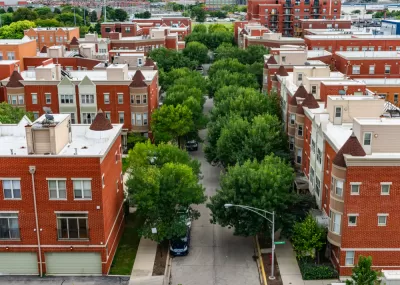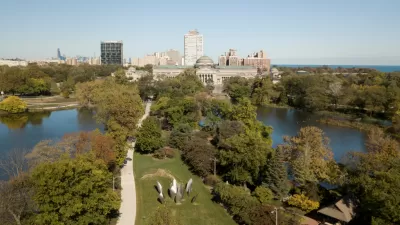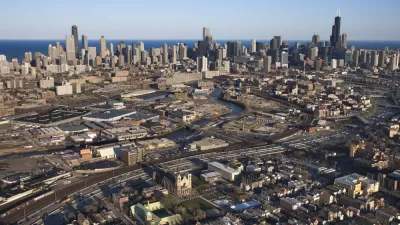In The Battle of Lincoln Park, Daniel Kay Hertz chronicles the gentrification of Lincoln Park, and shows how its residents displaced renters and the poor.

In his new book The Battle of Lincoln Park, blogger and policy analyst Daniel Kay Hertz writes about the process of gentrification in Lincoln Park, an affluent neighborhood on the North Side of Chicago.
In 1950, this area, like most of Chicago, was a white working-class neighborhood. Only 9 percent of residents had a college degree, and the area was the 15th poorest of Chicago's 75 neighborhoods. But in the 1950s and 1960s, middle-class people started renovating homes, and eventually made it one of the city’s richer areas. Unlike modern urbanists, Lincoln Park neighborhood activists were quite committed to the single-family home; for example, 1950s neighborhood association materials stated: "the renewal of Old Town [part of Lincoln Park] was based on a recognition of the inherent value of a low-density, family-oriented residential community close to the center of a great city."
Lincoln Park gentrifiers acted on this preference in a variety of ways—all of which tended to reduce population and housing stock. For example:
- Gentrifiers bought up small rooming houses and turned them into single-family houses, thus reducing the number of occupants.
- Gentrifiers urged the city to strictly enforce building codes in order to wipe out small apartment buildings full of poor people. One 1958 community newsletter declared a "smashing victory" in causing the demolition of a building, and noted "the eviction of undesirable tenants." Hertz cites another case in which a group of homeowners informed a nearby landlord that his building had fewer fire escapes than required by the city code—but when he proposed to build a new fire escape, other neighbors objected, claiming that the escape would devalue their property.
- Gentrifiers endorsed the city’s use of eminent domain to wipe out low-income housing. In 1964, neighborhood activists sought to persuade the city to demolish 2100 homes in 644 buildings.
- After taking over the neighborhood, the gentrifiers fought for restrictive zoning to keep out apartment buildings. They didn’t like high-end housing any more than they liked low-end housing; for example, one community newsletter described high-end apartments as "high priced slums for transients." Another neighborhood group called for using zoning laws to keep "living units to a reasonably large size." Neighborhood activists disliked mid-size housing as much as they disliked high-rises; for example, when developers began to build four-story apartments, one activist described them as "Glorified rooming houses and a potential slum situation."
Ultimately, Lincoln Park activists persuaded the city to go along with their ideas. The Chicago City Council banned four-story apartments in 1971, halted new high rises, and made parts of Lincoln Park a historic district to limit demolitions.
In 1975, one neighborhood newsletter claimed: "we are faced with an increasing overconcentration of people." This claim seems to have been completely false: In Old Town, the neighborhood population decreased from 9,700 to 5,500 between 1950 and 1970. In Lincoln Park as a whole, population nosedived from 102,000 in 1950 to 67,000 today. These declines were driven partially by smaller household sizes, but Lincoln Park also lost housing stock; Lincoln Park had almost 3,000 fewer housing units in 2016 than 1950. As a result of these policies, Lincoln Park became more house-dominated. In 1950, less than one in twenty neighborhood structures were single-family homes; today, nearly one in five are.
Lincoln Park also became steadily more expensive; land costs in Old Town rose from about $150 per foot in the late 1950s to as much as $700 per foot in 1968, and home values and rents also rose. Today, the median home value is $518,000, more than half the citywide average.
So what can we learn from this story? We learn that urban NIMBYism is nothing new: as soon as Lincoln Park’s gentrifiers moved, they sought to exclude unwelcome people, whether they be the blue-collar poor or white-collar singles. We learn that population growth and gentrification do not necessarily go together. We learn that restrictive zoning, far from being the enemy of gentrification and displacement, can be a useful tool in the displacer’s toolbox. And finally, we learn that downzoning often doesn't lead to lower land prices or housing costs.

Manufactured Crisis: Losing the Nation’s Largest Source of Unsubsidized Affordable Housing
Manufactured housing communities have long been an affordable housing option for millions of people living in the U.S., but that affordability is disappearing rapidly. How did we get here?

Americans May Be Stuck — But Why?
Americans are moving a lot less than they once did, and that is a problem. While Yoni Applebaum, in his highly-publicized article Stuck, gets the reasons badly wrong, it's still important to ask: why are we moving so much less than before?

Using Old Oil and Gas Wells for Green Energy Storage
Penn State researchers have found that repurposing abandoned oil and gas wells for geothermal-assisted compressed-air energy storage can boost efficiency, reduce environmental risks, and support clean energy and job transitions.

Greening Oakland’s School Grounds
With help from community partners like the Trust for Public Land, Oakland Unified School District is turning barren, asphalt-covered schoolyards into vibrant, green spaces that support outdoor learning, play, and student well-being.

California Governor Suspends CEQA Reviews for Utilities in Fire Areas
Utility restoration efforts in areas affected by the January wildfires in Los Angeles will be exempt from environmental regulations to speed up the rebuilding of essential infrastructure.

Native American Communities Prepare to Lead on Environmental Stewardship
In the face of federal threats to public lands and conservation efforts, indigenous groups continue to model nature-centered conservation efforts.
Urban Design for Planners 1: Software Tools
This six-course series explores essential urban design concepts using open source software and equips planners with the tools they need to participate fully in the urban design process.
Planning for Universal Design
Learn the tools for implementing Universal Design in planning regulations.
Heyer Gruel & Associates PA
City of Moreno Valley
Institute for Housing and Urban Development Studies (IHS)
City of Grandview
Harvard GSD Executive Education
Salt Lake City
NYU Wagner Graduate School of Public Service
City of Cambridge, Maryland






























